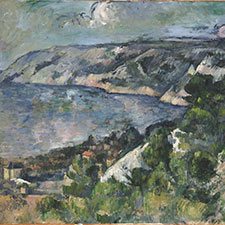Green Earth
Natural inorganic pigmentComposition and Properties Green Earth
Green earth is a natural inorganic pigment prepared from the minerals glauconite or celadonite. Both minerals have similar composition and are silicates with a crystal structure similar to mica. The chemical formula can be written as K[(Al,FeIII),(FeII,Mg](AlSi3,Si4)O10(OH)2.
It is soluble in acids and alkalis and turns brown on heating (burnt green earth). The pigment is not changed by light and is compatible with all other pigments.

Pigment

Painted swatch
Names
Color Index
PG 23, CI 77009
Grüne Erde
German
Terre verte
French
Terra verde
Italian
Tierra verda
Spanish
Preparation
Green earth can be prepared from the minerals celadonite or glauconite.
History of Use
Green earth has been in use since antiquity times until the present day. The following graph gives the frequency of its use in the paintings of the Schack Collection in the Bavarian State Art Collections in Munich (1).

An extensive collection of occurrences of verdigris in paintings from several historical periods can be found in the blog post ‘Pigment: the green earth of Cyprus by The Eclectic Light Company.
References
(1) Kühn, H., Die Pigmente in den Gemälden der Schack-Galerie, in: Bayerische Staatsgemäldesammlungen (Ed.) Schack-Galerie (Gemäldekataloge Bd. II), München 1969.
(2) David Hradil, Tomas Grygar, Janka Hradilova, Petr Bezdicka, Clay and iron oxide pigments in the history of painting, Applied Clay Science 22 (2003) 223–236
Examples of use
Duccio, The Virgin and Child, about 1312-15

The skin and flesh tones were painted in green earth and then overpainted with pink and white which faded with age so that the green colour is more prominent now than was originally intended (1).
(1) Dillian Gordon, Duccio di Buoninsegna, ‘The Virgin and Child with Saint Dominic and Saint Aurea, and Patriarchs and Prophets. In David Bomford, Jill Dunkerton, Dillian Gordon, Ashok Roy, Jo Kirby, National Gallery Catalogues, The Italian Paintings before 1400′, London 2011, pp. 188–201.
Jan Victors, The Greengrocer's Shop De Buyskool, 1654

Identification
Fiber Optics Reflectance Spectra (FORS)

Spectra by A. Cosentino, Cultural Heritage Science Open Source (CHSOS)
Infrared Spectrum
1. IR-Spectrum of Bohemian green earth in the ATR-FT-IR spectra of different pure inorganic pigments, University of Tartu, Estonia.
2. Spectrum of Bohemian green earth in linseed oil by S. Vahur, Database of ATR-IR spectra of materials related to paints and coatings, University of Tartu, Estonia
Raman Spectrum
 Spectrum by Ian M. Bell, Robin J.H. Clark and Peter J. Gibbs, Raman Spectroscopic Library
Spectrum by Ian M. Bell, Robin J.H. Clark and Peter J. Gibbs, Raman Spectroscopic Library
University College of London
X-Ray Fluorescence Spektrum (XRF)
XRF Spectrum in the Free XRF Spectroscopy Database of Pigments Checker, CHSOS website.
References
(1) Ligia Maria Moretto, Emilio Francesco Orsega, Gian Antonio Mazzocchin, Spectroscopic methods for the analysis of celadonite and glauconite in Roman green wall paintings, Journal of Cultural Heritage, Volume 12, Issue 4, October–December 2011, Pages 384–391.
(2) Fanost, A.; Gimat, A.; de Viguerie, L.; Martinetto, P.; Giot, A.-C.; Clémancey, M.; Blondin, G.; Gaslain, F.; Glanville, H.; Walter, P.; Mériguet, G.; Rollet, A.-L.; Jaber, M., Revisiting the identification of commercial and historical green earth pigments. Colloids and Surfaces A: Physicochemical and Engineering Aspects 2020, 584, 124035.
(3) Rafalska-Łasocha, Alicja & Kaszowska, Zofia & Lasocha, Wieslaw & Dziembaj, Roman. X-ray powder diffraction investigation of green earth pigments. Powder Diffraction – POWDER DIFFR. 25, 2010. DOI 10.1154/1.3308412.

Microphotograph
image © Volker Emrath
Further Reading
References
(1) Grissom, C.A. Green Earth, in Artists’ Pigments. A Handbook of Their History and Characteristics, Vol. 1: Feller, R.L. (Ed.) Oxford University Press 1986, p. 141 – 167. Available as pdf from the National Gallery of Art.
(2) Fanost, A.; Gimat, A.; de Viguerie, L.; Martinetto, P.; Giot, A.-C.; Clémancey, M.; Blondin, G.; Gaslain, F.; Glanville, H.; Walter, P.; Mériguet, G.; Rollet, A.-L.; Jaber, M., Revisiting the identification of commercial and historical green earth pigments. Colloids and Surfaces A: Physicochemical and Engineering Aspects 2020, 584, 124035.
(3) S. Muntwyler, J. Lipscher, HP. Schneider, Das Farbenbuch, 2nd. Ed., 2023, alataverlag Elsau, pp. 36-37.




















